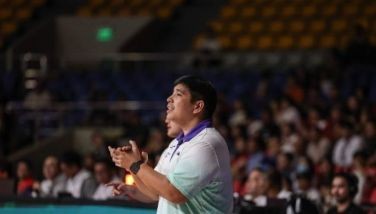Judging the judges by speed of work

July 11, 2003 | 12:00am
Never before has the judiciary been so disturbingly under public fire. Lawyers and litigants are loudly grumbling about patently wrong rulings and misconduct by judges. Complaints range from plain laziness to gross ignorance of the law to shameless corruption. It’s not mere sour-graping. For, winners gloat as loudly not about the strength of their arguments in open court but the sums that changed hands behind closed chambers or, at times, in cockpits.
Higher courts have not been spared from assault. Rightly or not, the Sandiganbayan has gained a reputation of a slowpoke; the Court of Appeals, of an auction house. Approval poll ratings of the Supreme Court remain higher than those of Malacañang and Congress, but its image too as the final repository of justice is being eroded.
It does not help any that losers run to the media for vengeance, as in the case of Piatco’s lawyers in the airport case or Sen. Panfilo Lacson in the Kuratong Baleleng appeal. Perhaps, as Chief Justice Hilario Davide fumes, "sinister forces" may indeed be out to ruin the Supreme Court. On behalf of Joseph Estrada, former senator Rene Saguisag has filed an impeachment rap in Congress against eight justices. Another Estrada counsel, Ateneo law lecturer Alan Paguia, at the same time asked the Sandiganbayan to subpoena Gloria Arroyo and reverse the three Supreme Court affirmations of her Presidency. All the while, mobs-for-hire picketed the Tribunal and the homes of selected justices.
The moves apparently aimed to pressure the justices while Estrada’s plunder defense is brought from the Sandiganbayan to the streets. Still, because of the legal luminaries involved, the public is growing confused or convinced with their words. In many campuses, students are organizing symposiums on what is happening to the judiciary. NGOs and civic clubs too are raising the question in their monthly forums. No longer are magistrates, like Caesar’s wife, beyond reproach.
The Tribunal, to be sure, acts decisively on complaints of corruption and misconduct. It has dismissed three Angeles City judges for extortion, and a Court of Appeals justice for interceding with the justice department for a jailed drug lord. But such actions are few and far between. For it takes courage to sue a magistrate and solid evidence to convict. Lawyers and litigants are prone to present their cases in coffeeshops.
But the most glaring example of judicial injustice is its slowness. Partly due to lawyers’ delaying tactics and judges’ huge work loads, cases drag for years in lower courts. And because no one accepts defeat in this litigious society, cases drag for more years when elevated to the Court of Appeals on the slighest pretext. Even at the Supreme Court where rulings are deemed final, decisions by five-man divisions are raised before the en banc. And even when the en banc decides, it takes more years to execute.
Delaying tactics and work loads are no excuses. The Supreme Court requires judges to render decisions within 90 days after hearing both sides. Special courts have 90 days for trials. At one time, the Tribunal questioned no less than the Sandiganbayan presiding justice for sitting on more than a hundred cases for three years. Yet courts get away with broken deadline. Worse, the Supreme Court is not bound by its own rules. Besides, courts do not control lawyers and state prosecutors.
Among the many cases overstaying in courts are those on ill-gotten wealth of the Marcoses. Participants of EDSA-2 jeer Saguisag whenever he defends Estrada whom they forced to resign, but participants of EDSA -1 cheer him on when he lambasts both prosecutors and justices in charge of long-drawn Marcos cases. Pointing to two deteriorating Marcos mansions, he wails at "the seeming inability of government prosecutors to present strong evidence against the accused, for reasons known only to them." The Presidential Commission on Good Government, Saguisag notes, had announced on July 11, 2001 that it was confident of meeting its self-imposed two-year deadline to resolve the cases against the heirs of the ousted and long-deceased dictator. That deadline lapses today, yet the PCGG has yet to decide whether or not to file dozens of suits.
Many other cases against the Marcoses have been awaiting court decision for over a decade. "The government has squandered valuable time and opportunities to make use of the huge wealth to be recovered, which can help solve the perennial budgetary deficity problem," Saguisag cries. "What is being claimed remains contested after more than 15 years. Meanwhile, the true owners of the disputed wealth have themselves become victims of injustice since they have been deprived of their wealth for many years, especially if they turn out to be innocent of the charges."
Saguisag’s interest in the cases is as counsel for 10,000 victims of human rights violations during Marcos’s martial law who had won a $2-billion damage suit in the US. "If found guilty, the Marcoses and their cronies must be punished, so the thousands of victims can finally collect" Saguisag says. "If innocent, they should be cleared." Any which way, the courts must now decide.
The PCGG believes that the Marcoses stashed away more than P88 billion in public funds. Most of those recovered were surrendered to it by cronies in out-of-court settlements.
Billions of pesos more in coconut levy funds remains tied up in litigation. Yet the principal accused, San Miguel Corp. chairman Eduardo Cojuangco Jr., is not even claiming it as his. "It’s simple. The money is not mine. It belongs to the coconut farmers," he says. Yet the cases have dragged for 16 years. "And we haven’t even reached the pre-trial stage," he sighs. Now you be the judge.
Catch Sapol ni Jarius Bondoc, Saturday, 8 a.m., on DWIZ (882-AM).
E-mail: [email protected]
Higher courts have not been spared from assault. Rightly or not, the Sandiganbayan has gained a reputation of a slowpoke; the Court of Appeals, of an auction house. Approval poll ratings of the Supreme Court remain higher than those of Malacañang and Congress, but its image too as the final repository of justice is being eroded.
It does not help any that losers run to the media for vengeance, as in the case of Piatco’s lawyers in the airport case or Sen. Panfilo Lacson in the Kuratong Baleleng appeal. Perhaps, as Chief Justice Hilario Davide fumes, "sinister forces" may indeed be out to ruin the Supreme Court. On behalf of Joseph Estrada, former senator Rene Saguisag has filed an impeachment rap in Congress against eight justices. Another Estrada counsel, Ateneo law lecturer Alan Paguia, at the same time asked the Sandiganbayan to subpoena Gloria Arroyo and reverse the three Supreme Court affirmations of her Presidency. All the while, mobs-for-hire picketed the Tribunal and the homes of selected justices.
The moves apparently aimed to pressure the justices while Estrada’s plunder defense is brought from the Sandiganbayan to the streets. Still, because of the legal luminaries involved, the public is growing confused or convinced with their words. In many campuses, students are organizing symposiums on what is happening to the judiciary. NGOs and civic clubs too are raising the question in their monthly forums. No longer are magistrates, like Caesar’s wife, beyond reproach.
The Tribunal, to be sure, acts decisively on complaints of corruption and misconduct. It has dismissed three Angeles City judges for extortion, and a Court of Appeals justice for interceding with the justice department for a jailed drug lord. But such actions are few and far between. For it takes courage to sue a magistrate and solid evidence to convict. Lawyers and litigants are prone to present their cases in coffeeshops.
But the most glaring example of judicial injustice is its slowness. Partly due to lawyers’ delaying tactics and judges’ huge work loads, cases drag for years in lower courts. And because no one accepts defeat in this litigious society, cases drag for more years when elevated to the Court of Appeals on the slighest pretext. Even at the Supreme Court where rulings are deemed final, decisions by five-man divisions are raised before the en banc. And even when the en banc decides, it takes more years to execute.
Delaying tactics and work loads are no excuses. The Supreme Court requires judges to render decisions within 90 days after hearing both sides. Special courts have 90 days for trials. At one time, the Tribunal questioned no less than the Sandiganbayan presiding justice for sitting on more than a hundred cases for three years. Yet courts get away with broken deadline. Worse, the Supreme Court is not bound by its own rules. Besides, courts do not control lawyers and state prosecutors.
Among the many cases overstaying in courts are those on ill-gotten wealth of the Marcoses. Participants of EDSA-2 jeer Saguisag whenever he defends Estrada whom they forced to resign, but participants of EDSA -1 cheer him on when he lambasts both prosecutors and justices in charge of long-drawn Marcos cases. Pointing to two deteriorating Marcos mansions, he wails at "the seeming inability of government prosecutors to present strong evidence against the accused, for reasons known only to them." The Presidential Commission on Good Government, Saguisag notes, had announced on July 11, 2001 that it was confident of meeting its self-imposed two-year deadline to resolve the cases against the heirs of the ousted and long-deceased dictator. That deadline lapses today, yet the PCGG has yet to decide whether or not to file dozens of suits.
Many other cases against the Marcoses have been awaiting court decision for over a decade. "The government has squandered valuable time and opportunities to make use of the huge wealth to be recovered, which can help solve the perennial budgetary deficity problem," Saguisag cries. "What is being claimed remains contested after more than 15 years. Meanwhile, the true owners of the disputed wealth have themselves become victims of injustice since they have been deprived of their wealth for many years, especially if they turn out to be innocent of the charges."
Saguisag’s interest in the cases is as counsel for 10,000 victims of human rights violations during Marcos’s martial law who had won a $2-billion damage suit in the US. "If found guilty, the Marcoses and their cronies must be punished, so the thousands of victims can finally collect" Saguisag says. "If innocent, they should be cleared." Any which way, the courts must now decide.
The PCGG believes that the Marcoses stashed away more than P88 billion in public funds. Most of those recovered were surrendered to it by cronies in out-of-court settlements.
Billions of pesos more in coconut levy funds remains tied up in litigation. Yet the principal accused, San Miguel Corp. chairman Eduardo Cojuangco Jr., is not even claiming it as his. "It’s simple. The money is not mine. It belongs to the coconut farmers," he says. Yet the cases have dragged for 16 years. "And we haven’t even reached the pre-trial stage," he sighs. Now you be the judge.
BrandSpace Articles
<
>
- Latest
- Trending
Trending
Latest
Trending
Recommended

January 18, 2025 - 3:29pm



























